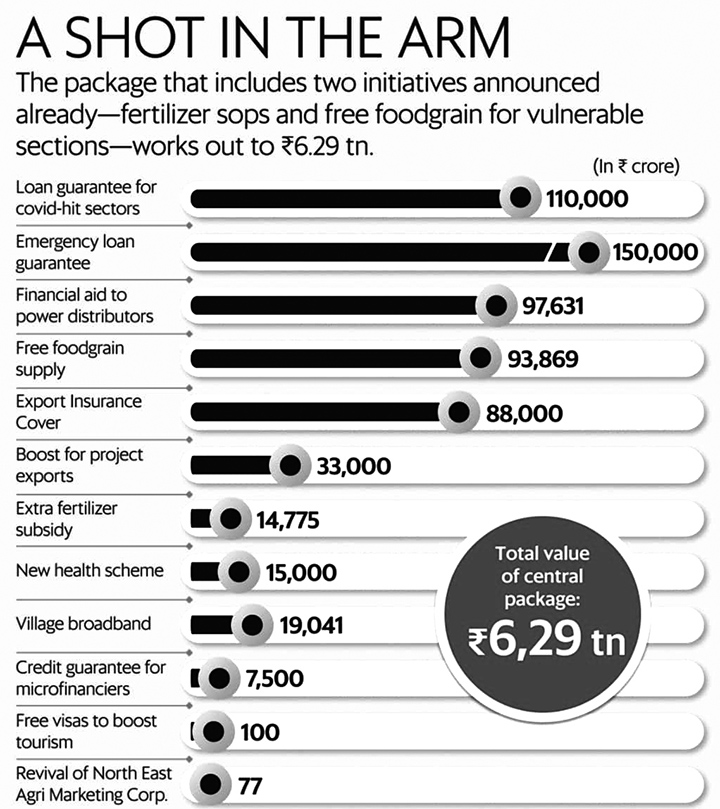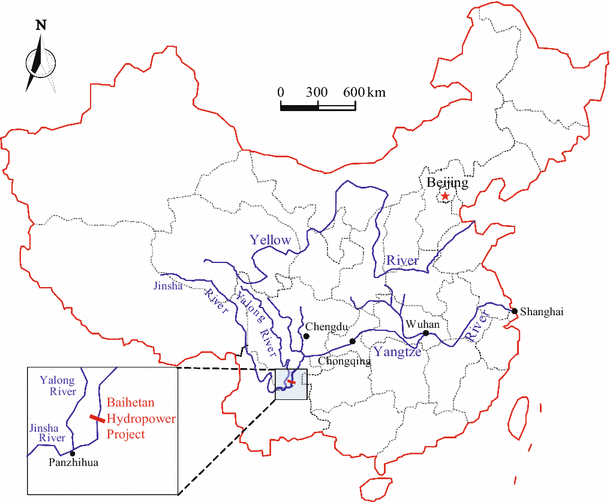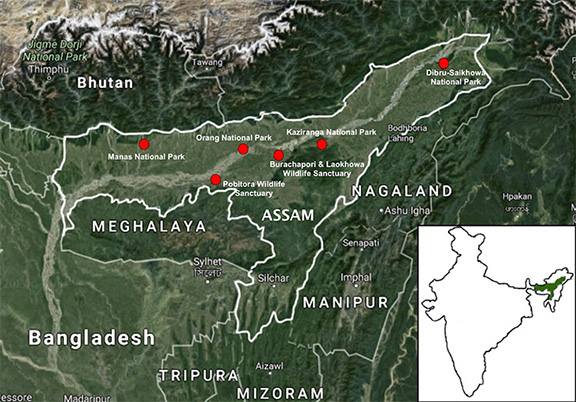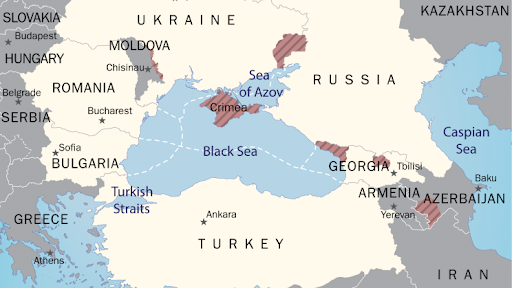Indian Economy
Economic Relief Package after Covid- Second Wave
Why in News
Recently, the Ministry of Finance announced a slew of measures to provide relief to diverse sectors affected by the second wave of Covid-19 pandemic.
- It aims to prepare the health systems for emergency response and provide impetus for growth and employment. However it will increase the Fiscal Deficit by 0.6% as per a report of State Bank of India.
- A total of 17 measures amounting to Rs. 6,28,993 crore were announced in the Economic Relief Package.
Key Points
- Economic Relief from Pandemic:
- Loan Guarantee Scheme for Covid Affected Sectors:
- Additional credit of Rs 1.1 lakh crore will flow to the businesses. This includes Rs 50,000 crore for the health sector and Rs 60,000 crore for other sectors, including tourism.
- The health sector component is aimed at scaling medical infrastructure targeting underserved areas (i.e. non-metropolitan areas).
- Guarantee Coverage: 50% for expansion & 75% for new projects.
- For aspirational districts, the guarantee cover of 75% will be available for both new projects and expansion.
- Maximum loan admissible under the scheme is Rs. 100 crore and guarantee duration is up to 3 years.
- Additional credit of Rs 1.1 lakh crore will flow to the businesses. This includes Rs 50,000 crore for the health sector and Rs 60,000 crore for other sectors, including tourism.
- Emergency Credit Line Guarantee Scheme:
- Expand the Emergency Credit Line Guarantee Scheme (ECLGS), launched as part of Atmanirbhar Bharat Package in May, 2020, by Rs 1.5 lakh crore.
- Credit Guarantee Scheme for Micro Finance Institutions:
- It is a new scheme which aims to benefit the smallest of the borrowers who are served by the network of Micro Finance Institutions (MFIs).
- Guarantee will be provided to Scheduled Commercial Banks for loans to new or existing Non-Banking Financial Company (NBFC)-MFIs or MFIs for on lending upto Rs 1.25 lakh to approximately 25 lakh small borrowers.
- Extension of Aatmanirbhar Bharat Rozgar Yojana (ANBRY):
- ANBRY incentivises employers for creation of new employment, restoration of loss of employment through Employees’ Provident Fund Organisation (EPFO).
- Pradhan Mantri Garib Kalyan Ann Yojana:
- To the beneficiaries under the National Food Security Act (NFSA), 2013, 5 kg of food grains per month free will be provided during May-November 2021.
- Loan Guarantee Scheme for Covid Affected Sectors:
- Strengthening Public Health:
- New Scheme for Children and Paediatric Care:
- A new scheme for strengthening public health infrastructure and human resources with outlay of Rs. 23,220 crore was also announced.
- It will focus on short term emergency preparedness with special emphasis on children and paediatric care/paediatric beds.
- New Scheme for Children and Paediatric Care:
- Growth & Employment:
- Free one month tourist visa to 5 lakh tourists.
- Additional Subsidy for DAP & P&K fertilizers.
- Climate Resilient Special Traits Varieties:
- Indian Council of Agricultural Research (ICAR) has developed biofortified crop varieties having high nutrients like protein, iron, zinc, vitamin-A.
- These varieties are tolerant to diseases, insects, pests, drought, salinity, and flooding, early maturing and amenable to mechanical harvesting also developed.
- 21 such varieties of rice, peas, millet, maize, soyabean, quinoa, buckwheat, winged bean, pigeon pea & sorghum will be dedicated to the nation.
- Revival of North Eastern Regional Agricultural Marketing Corporation :
- A revival package of Rs 77.45 crore will be provided to North Eastern Regional Agricultural Marketing Corporation (NERAMAC).
- NERAMAC has facilitated registration of 13 Geographical Indicator (GI) crops of North-East.
- It has prepared a plan to give 10-15% higher price to farmers by-passing middlemen/agents.
- It also proposes to set up North-Eastern Centre for Organic Cultivation, facilitating equity finance to entrepreneurs.
- Boost for Project Exports:
- It has been decided to provide an additional corpus to the National Export Insurance Account (NEIA) over 5 years. This will enable it to underwrite additional Rs. 33,000 crore of project exports.
- NEIA Trust promotes Medium and Long Term (MLT) project exports by extending risk covers.
- It provides cover to buyer’s credit, given by EXIM (Export-Import) Bank, to less credit-worthy borrowers and supporting project exporters.
- It has been decided to provide an additional corpus to the National Export Insurance Account (NEIA) over 5 years. This will enable it to underwrite additional Rs. 33,000 crore of project exports.
- Boost to Export Insurance Cover:
- It has been decided to infuse equity in Export Credit Guarantee Corporation (ECGC) over 5 years to boost export insurance cover by Rs. 88,000 crore.
- Digital India:
- Additional Rs. 19,041 crore will be provided to implement Bharat Net in PPP model in 16 States on viability gap funding basis.
- This will enable expansion and upgradation of Bharat Net to cover all Gram Panchayats and inhabited villages.
- Extension of PLI Scheme:
- Tenure of Production-Linked Incentive (PLI) scheme for Large Scale Electronics Manufacturing has been decided to be extended by one year i.e. till 2025-26.
- Reform-Based Result-Linked Power Distribution Scheme:
- Revamped Reforms-Based, Result-Linked power distribution scheme of financial assistance to DISCOMS for infrastructure creation, up-gradation of system, capacity building and process improvement was announced in the Union Budget of 2021-22.
- It aims at state specific intervention and to provide assistance for installation of 25 crore smart meters, 10,000 feeders, 4 lakh km of LT overhead lines.
- The amount available under the scheme is in addition to the allowed additional borrowing of 0.5% of Gross Domestic Product of State which will be available to the States annually for the next four years subject to carrying out specific power sector reforms.
- Ongoing works of Integrated Power Development Scheme (IPDS), Deendayal Upadhyaya Gram Jyoti Yojana (DDUGJY) and SAUBHAGYA will also be merged in the scheme.
- Revamped Reforms-Based, Result-Linked power distribution scheme of financial assistance to DISCOMS for infrastructure creation, up-gradation of system, capacity building and process improvement was announced in the Union Budget of 2021-22.
- New streamlined process for PPP Projects and Asset Monetization:
- A new policy will be formulated for appraisal and approval of Public-Private Partnerships (PPP) proposals and monetization of core infrastructure assets, including through Infrastructure Investment Trusts (InvITs).
- The policy will aim to ensure speedy clearance of projects to facilitate private sector’s efficiencies in financing construction and management of infrastructure.
Significance of the Package
- It would usher in much-needed liquidity and help revive the employment-intensive sectors such as tourism.
- It will help save livelihoods and mitigate further closures and also create new job opportunities.
- It will bolster efforts for any such healthcare challenges in the future.
- It will enable the Covid-affected Sectors to rise from the challenges they had faced over the past year and a half.
- The liquidity for small businesses could indirectly revive the fortunes of larger industries they source from and help repair broken supply chains.
Governance
Gujarat Prohibition Law
Why in News
Recently, the Gujarat Prohibition Act, 1949 has been challenged before the Gujarat High Court, more than seven decades after it came into effect as the Bombay Prohibition Act.
- The prohibition on manufacture, sale and consumption of liquor in the state vide the Gujarat Prohibition Act, 1949, has been challenged on grounds of 'manifest arbitrariness' and violation of 'right to privacy'.
Key Points
- Background:
- Bombay Abkari Act, 1878: The first hint at the prohibition of liquor was through the Bombay Abkari Act, 1878 (in the Province of Bombay).
- This Act dealt with levying of duties on intoxicants, among other things and aspects of prohibition via amendments made in 1939 and 1947.
- Bombay Prohibition Act, 1949: There were “many lacuna” in the Bombay Abkari Act, 1878, from the point of view of the government’s decision to enforce prohibition.
- This led to the birth of Bombay Prohibition Act, 1949.
- The Supreme Court (SC) upheld the Act broadly barring a few sections in 1951 in the judgment of State of Bombay and another versus FN Balsara.
- Gujarat Prohibition Act, 1949:
- Following the reorganisation of Bombay province into the states of Maharashtra and Gujarat in 1960, there was continued amendment and liberalisation in the state of Maharashtra, especially in 1963.
- The ground for the liberalisation of the law was to check the business of illicit liquor.
- Gujarat adopted the prohibition policy in 1960 and subsequently chose to enforce it with greater rigidity, but also made processes easier for foreign tourists and visitors to get liquor permits.
- In 2011, the Act was renamed as Gujarat Prohibition Act. In 2017, the Gujarat Prohibition (Amendment) Act was passed with provision of up to ten years jail for manufacturing, purchase, sale and transportation of liquor in the dry state.
- Following the reorganisation of Bombay province into the states of Maharashtra and Gujarat in 1960, there was continued amendment and liberalisation in the state of Maharashtra, especially in 1963.
- Bombay Abkari Act, 1878: The first hint at the prohibition of liquor was through the Bombay Abkari Act, 1878 (in the Province of Bombay).
- Grounds for Challenging the Act:
- The right of privacy: Any invasion by the state in an individual’s right to choice of food and beverage amounts to an unreasonable restriction and destroys the individual’s decisional and bodily autonomy.
- Right to privacy has been held as a fundamental right by the Supreme Court in several judgments since 2017.
- Ground of Manifest Arbitrariness: It has been especially highlighted while challenging sections pertaining to grant of health permits and temporary permits to out-of-state tourists.
- The petitioner says that there are no intelligible differences in the classes thus being created by the state on who gets to drink and who does not and violates the Right to Equality under Article 14 of the Constitution.
- The right of privacy: Any invasion by the state in an individual’s right to choice of food and beverage amounts to an unreasonable restriction and destroys the individual’s decisional and bodily autonomy.
- Counter Argument:
- Aggravate the Sense of Violence: Various research and studies have shown that alcohol tends to aggravate the sense of violence.
- Most of the domestic violence crimes against women and children are committed behind closed doors.
- Constitutional Obligation of State: Challenging the law, is an “attack on the constitutional obligation of the primary duty of the State as the guardian of the population to protect the health and lives of its people”.
- National Prohibition was advocated by Mahatma Gandhi.
- Aggravate the Sense of Violence: Various research and studies have shown that alcohol tends to aggravate the sense of violence.
- Arguments Against Prohibition:
- Loss of Revenue: Tax revenues from alcohol is a major part of any government’s revenues. These enable the government to finance several public welfare schemes. Absence of these revenues severely impacts state’s ability to run public welfare programmes.
- Burden on Judiciary: Bihar introduced complete prohibition in April 2016. While it certainly has led to reduction in alcohol consumption, the related social, economic, and administrative costs have been far too much to justify gains. Prohibition crippled the judicial administration.
- So far over 2.14 lakh cases have been registered under the Act; 2.55 lakh people have been booked and 1.67 lakh arrests have been made.
- Ironically, liquor sales in districts in Uttar Pradesh and West Bengal bordering Bihar have seen a sharp rise.
- Source of Employment: Today, Indian Made Foreign Liquors (IMFL) industry contributes over 1 lakh crore in taxes every year. It supports the livelihood of 35 lakh farming families and provides direct and indirect employment to lakhs of workers employed in the industry.
- Prohibition in Other States:
- Alcohol prohibition is in force in the states of Bihar, Mizoram, Nagaland and the union territory of Lakshadweep.
- Related Constitutional Provisions:
- State Subject: Alcohol is a subject in the State list under the seventh schedule of the Indian Constitution.
- Article 47: The Directive Principle in the Constitution of India states that “The state shall undertake rules to bring about prohibition of the consumption except for medicinal purposes of intoxicating drinks and of drugs which are injurious to health”.
Way Forward
- Between issues such as morality, prohibition or freedom of choice, there are also factors like economy, jobs, etc, which cannot be ignored. What is required is an informed and constructive dialogue on the causes and effects.
- Policy makers should focus on framing laws which encourage responsible behavior and compliance.
- Drinking age should be made uniform across the country and no person below that should be permitted to buy alcohol.
- Tough laws should be made against drunken behaviour in public, domestic violence under influence, and drinking and driving.
- The governments should set aside part of revenue earned from alcohol for social education, de-addiction, and community support.
Internal Security
Agni-P (Prime)
Why in News
Recently, a new generation nuclear capable ballistic missile Agni-P (Prime) was successfully test-fired by the Defence Research and Development Organisation (DRDO) from Dr. APJ Abdul Kalam island off the coast of Odisha, Balasore.
Key Points
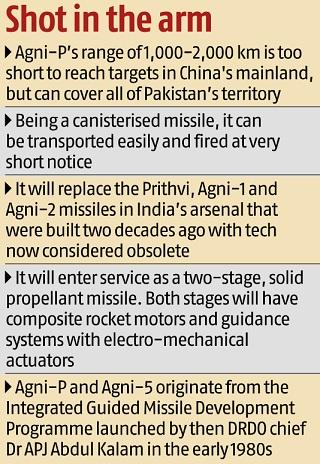 Agni-P is a new generation advanced variant of the Agni class (under IGMDP - Integrated Guided Missile Development Program).
Agni-P is a new generation advanced variant of the Agni class (under IGMDP - Integrated Guided Missile Development Program).- It is a canisterised missile with range capability between 1,000 and 2,000 km.
- Canisterisation of missiles reduces the time required to launch the missile while improving its storage and mobility.
- Many advanced technologies including composites, propulsion systems, innovative guidance and control mechanisms and state-of-the-art navigation systems have been introduced. The Agni-P missile would further strengthen India's credible deterrence capabilities.
- In comparison to other Agni class missiles, Agni-P has improved parameters including manoeuvring and accuracy.
- Agni Class of Missiles:
- They are the mainstay of India’s nuclear launch capability.
- Range of other Agni Missiles:
- Agni I: Range of 700-800 km.
- Agni II: Range more than 2000 km.
- Agni III: Range of more than 2,500 Km
- Agni IV: Range is more than 3,500 km and can fire from a road mobile launcher.
- Agni-V: The longest of the Agni series, an Inter-Continental Ballistic Missile (ICBM) with a range of over 5,000 km.
IGMDP (Integrated Guided Missile Development Program)
- It was conceived by Dr. A.P.J. Abdul Kalam to enable India attain self-sufficiency in the field of missile technology. It was approved by the Government of India in 1983 and completed in March 2012.
- The 5 missiles (P-A-T-N-A) developed under this program are:
- Prithvi: Short range surface to surface ballistic missile.
- Agni: Ballistic missiles with different ranges, i.e. Agni (1,2,3,4,5)
- Trishul: Short range low level surface to air missile.
- Nag: 3rd generation anti-tank missile.
- Akash: Medium range surface to air missile.
Canister Based Launch System
- Canister based launch system- serves as a container for transportation; a housing during storage aboard a vessel; provides operational flexibility.
- A canister launch system can be either hot launch, where the missile ignites in the cell, or cold launch, where the missile is expelled by gas produced by a gas generator which is not part of the missile itself, and then the missile ignites.
- Cold launch is safer than hot launch as the ejection system will eject the missile by itself even if there is a missile failure. In case of Agni V, it will be a cold launch.
- In case of hot launches, the problem is the heat produced by the missile at the time of launch. The hot launch is better for small missiles as the ejection part itself will be done by using the missile's own engine.
- Nuclear Triad:
- Nuclear triad, a three-sided military-force structure consisting of land-launched nuclear missiles, nuclear-missile-armed submarines, and strategic aircraft (e.g. Rafale, Brahmos) with nuclear bombs and missiles.
- DRDO had in January 2020 successfully test-fired a 3,500-km range submarine-launched ballistic missile, K-4, from a submerged pontoon off the Visakhapatnam coast.
- Once inducted, these missiles will be the mainstay of the Arihant class of indigenous ballistic missile nuclear submarines (SSBN) and will give India the stand-off capability to launch nuclear weapons submerged in Indian waters.
- INS Arihant, the only SSBN in service, is armed with K-15 missiles with a range of 750 km.
- In the past few years, India has been able to complete its nuclear triad. This is especially important given India’s No-First-Use policy while reserving the right of massive retaliation if struck with nuclear weapons first.
Indian Polity
Attorney General of India
Why in News
The central government has extended the term of K.K. Venugopal as Attorney General (AG) for one more year.
- This is the second time the Centre has extended his tenure. Venugopal received his first extension of term in 2020.
- Venugopal was appointed the 15th AG of India in 2017. He succeeded Mukul Rohatgi who was AG from 2014-2017.
- He would be in command of the government’s legal defence in several sensitive cases pending in the Supreme Court, which includes the challenge to the abrogation of Article 370 of the Constitution and the Citizenship Amendment Act.
Key Points
- About:
- The Attorney General (AG) of India is a part of the Union Executive. AG is the highest law officer in the country.
- Article 76 of the Constitution provides for the office of AG of India.
- Appointment and Eligibility:
- AG is appointed by the President on the advice of the government.
- S/he must be a person who is qualified to be appointed a judge of the Supreme Court, i.e. s/he must be a citizen of India and must have been a judge of some high court for five years or an advocate of some high court for ten years or an eminent jurist, in the opinion of the President.
- Term of the Office: Not fixed by the Constitution.
- Removal: Procedures and grounds for the removal of AG are not stated in the Constitution. S/he holds office during the pleasure of the President (may be removed by the President at any time).
- Duties and Functions:
- To give advice to the Government of India (GoI) upon such legal matters, which are referred to her/him by the President.
- To perform such other duties of a legal character that are assigned to her/him by the President.
- To appear on behalf of the GoI in all cases in the Supreme Court or in any case in any High Court in which the GoI is concerned.
- To represent the GoI in any reference made by the President to the Supreme Court under Article 143 (Power of the President to consult the Supreme Court) of the Constitution.
- To discharge the functions conferred on her/him by the Constitution or any other law.
- Rights and Limitations:
- S/he has the right to speak and to take part in the proceedings of both the Houses of Parliament or their joint sitting and any committee of the Parliament of which s/he may be named a member, but without a right to vote.
- S/he enjoys all the privileges and immunities that are available to a member of Parliament.
- S/he does not fall in the category of government servants. S/he is not debarred from private legal practice.
- However, s/he should not advise or hold a brief against the GoI.
- Solicitor General of India and Additional Solicitor General of India assist the AG in fulfillment of the official responsibilities.
- Corresponding Office in the States: Advocate General (Article 165).
Indian Economy
Interest Rates on Small Saving Schemes
Why in News
Government may reduce interest rates on small saving schemes for the July - September Quarter.
- A cut in small savings rates at this point would further hurt households amid a surge in inflation, according to economists.
Key Points
- Background:
- Small savings rates were slashed between 0.5% and 1.4% on different instruments in April 2020, bringing the PPF (Public Provident Funds) rate to 7.1% from 7.9%.
- The government decided to further slash interest rates for the first quarter of 2021-22 (April-June), but withdrew its decision terming it an "oversight".
- Small Saving Schemes/Instruments:
- About:
- They are the major source of household savings in India and comprises 12 instruments.
- The depositors get an assured interest on their money.
- Collections from all small savings instruments are credited to the National Small Savings Fund (NSSF).
- Small savings have emerged as a key source of financing the government deficit, especially after the Covid-19 pandemic led to a ballooning of the government deficit, necessitating higher need for borrowings.
- Classification: Small savings instruments can be classified under three heads:
- Postal Deposits (comprising savings account, recurring deposits, time deposits of varying maturities and monthly income scheme).
- Savings Certificates: National Small Savings Certificate (NSC) and Kisan Vikas Patra (KVP).
- Social Security Schemes: Sukanya Samriddhi Scheme, Public Provident Fund (PPF) and Senior Citizens‘ Savings Scheme (SCSS).
- Determination of Rates:
- Interest rates on small savings schemes are reset on a quarterly basis, in line with the movement in benchmark government bonds of similar maturity. The rates are reviewed periodically by the Ministry of Finance.
- For the last one year, yields on benchmark government bonds have ranged between 5.7% and 6.2%. This provides the government the leeway to cut rates on small savings schemes in future.
- The Shyamala Gopinath panel (2010) constituted on the Small Saving Scheme had suggested a market-linked interest rate system for small savings schemes.
- Interest rates on small savings schemes are reset on a quarterly basis, in line with the movement in benchmark government bonds of similar maturity. The rates are reviewed periodically by the Ministry of Finance.
- About:
- Advantage of the Rate Cut:
- Since the central government uses the small savings fund to finance its deficit, the lower rates would reduce the cost of deficit financing.
- A cut in rates would mean that the government wants people to spend and provide impetus to the economy.
- Disadvantage:
- Rate cuts would hurt investors, particularly senior citizens and the middle class.
- Moreover, household savings have been shrinking significantly for two quarters in a row even before the second Covid-19 wave.
- This would lead to further rationalisation of fixed deposit rates by banks going forward, and would reduce returns further.
- A lower rate would mean a negative real rate of return on most debt instruments as inflation is hovering around 5%.
- Rate cuts would hurt investors, particularly senior citizens and the middle class.
Rate of Return and Inflation
- The rate of return is the expected or desired amount of money a person receives from an investment in a savings account, mutual fund or bond.
- The real rate of return is the return on investment after adjusting for the rate of inflation. It is calculated by subtracting the inflation rate from the return on investment.
- Inflation has the power to erode a person's annual rate of return. When the annual inflation rate exceeds the rate of return, the consumer loses money when they invest it because of the decline in purchasing power.
- Inflation refers to the rise in the prices of most goods and services of daily or common use, such as food, clothing, housing, recreation, transport, consumer staples, etc. It is indicative of the decrease in the purchasing power of a unit of a country’s currency.
Geography
Baihetan Dam: World’s Second Biggest Hydropower Dam
Why in News
Recently, China has put into operation the Baihetan Dam, world’s Second Biggest Hydropower Dam.
- The Three Gorges Dam is the largest hydropower dam in the world and is also along China’s Yangtze River. It began operations in 2003.
Key Points
- About the Dam:
- It is on the Jinsha River, a tributary of the Yangtze (the longest river in Asia).
- It has been built with a total installed capacity of 16,000 megawatts.
- It will eventually be able to generate enough electricity each day once to meet the power needs of 5,00,000 people for an entire year.
- Significance for China:
- It is part of Chinese efforts to curb surging fossil fuel demand by building more hydropower capacity.
- This comes at a time when dams have fallen out of favor in other countries due to environmental complaints (such as flooding farmland and disruption of the ecology of rivers, threatening fish and other species).
- China’s pledge in 2020 to reach carbon neutrality by 2060 had also added urgency to the construction.
- It is part of Chinese efforts to curb surging fossil fuel demand by building more hydropower capacity.
- China’s Other Upcoming Projects:
- China's planned mega-dam in Tibet's Medog County, which is set to surpass the Three Gorges Dam in size, has been described by analysts as a threat to Tibetan cultural heritage and a way for Beijing to effectively control a substantial portion of India's water supply.
- The plan is to build a dam on the lower reaches of the Brahmaputra River.
- The Brahmaputra (called Yarlung Tsangpo in China) is one of the longest rivers in the world.
- Starting in the Himalayas in Tibet, it enters India in Arunachal Pradesh, then passes through Assam, Bangladesh, and empties into the Bay of Bengal.
- The impact of dams on China's portion of the Mekong has also raised fears that irreversible damage is being inflicted upon a waterway which feeds 60 million people downstream as it winds through to the Vietnamese Delta.
- China's planned mega-dam in Tibet's Medog County, which is set to surpass the Three Gorges Dam in size, has been described by analysts as a threat to Tibetan cultural heritage and a way for Beijing to effectively control a substantial portion of India's water supply.
- Concerns:
- Agriculture:
- A huge dam (like on Brahmaputra) could hold back the massive amount of silt carried by the river (Silty soil is more fertile than other types of soil and it is good for growing crops.)
- This could affect farming in the areas downstream.
- Water Resources:
- India is also worried about the release of water during the monsoons, when north-eastern states such as Assam experience floods.
- Change in the flow rate during times of standoff between the countries is also a cause of concern.
- During the 2017 Doklam border standoff between India and China, China stopped communication of water flow levels from its dams.
- Ecological Impact:
- The ecosystem in the Himalayan region is already on the decline. Several species of flora and fauna are endemic to this part of the world and some of them are critically endangered. It could have disastrous consequences in this ecologically sensitive zone.
- The massive engineering projects have also displaced hundreds of thousands of local communities and prompted concern in neighbouring countries.
- Agriculture:
Way Forward
- India has urged China to ensure that the interests of downstream states are not harmed by any activity in upstream areas. Meanwhile, India is considering building a 10 gigawatts (GW) hydropower project in the Dibang valley in Arunachal Pradesh, to mitigate the adverse impact of the Chinese dam.
- However, the larger point is that too much hydro-power development is not a great idea in a fragile mountainscape.
Biodiversity & Environment
Barnadi Wildlife Sanctuary: Assam
Why in News
Recently, the World Wide Fund for Nature-India (WWF) found a few tigers inhabiting the Barnadi Wildlife Sanctuary in Assam.
- It is one of the smallest WS (Wildlife Sanctuary) of Assam and covers an area of 26.22 sq. km.
Key Points
- Location:
- Barnadi Wildlife Sanctuary (BWS) is located in northern Assam’s Baksa and Udalguri districts bordering Bhutan.
- The Sanctuary is bordered by the Barnadi river and Nalapara river to the west and east respectively.
- Legal Status:
- It was affirmed as the WS in 1980 by the Government of Assam.
- Barnadi was established specifically to protect the Pygmy Hog (Sus salvanius) and Hispid Hare (Caprolagus hispidus).
- Biodiversity:
- This is important for threatened species such as the Asian Elephant (Elephas maximus), Tiger (Panthera tigris) and Gaur Bos frontalis.
- About 60% of the BWS is reported to be grassland, most of it is now grassy woodland.
- The main Forest types are Tropical Moist Deciduous along the northern edge of the Sanctuary, and mixed scrub and grassland in the southern part with few trees.
- Vegetation:
- The vegetation has been drastically modified by human activity.
- Most of the natural vegetation has been cleared and replaced by commercial plantations of Bombax ceiba, Tectona grandis and Eucalyptus and by thatch grasses (mostly Saccharum, with some Phragmites and Themeda).
- Other Protected Areas in Assam:
- Dibru-Saikhowa National Park,
- Manas National Park,
- Nameri National Park,
- Rajiv Gandhi Orang National Park.
- Kaziranga National Park.
Hispid Hare/Assam Rabbit (Caprolagus hispidus)
- Habitat:
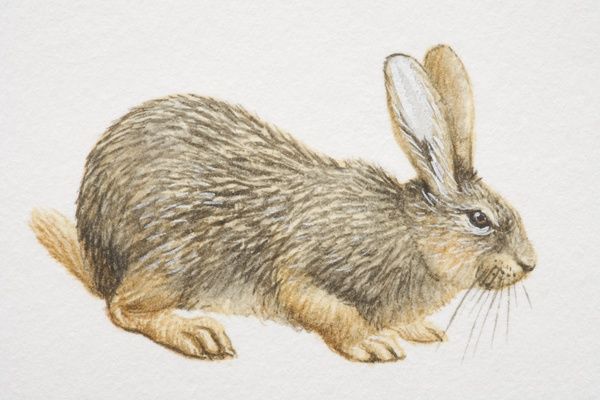
- Southern foothills of the central Himalayas.
- Occupies tracts of early successional tall grasslands, locally termed elephant grass. During the dry season, most grassy areas are subject to burning, and the rabbits take refuge in marshy areas or grasses adjacent to river banks that are not susceptible to burning.
- Threats:
- The habitat of hispid hares is highly fragmented due to increasing agriculture, flood control, and human development.
- Natural process of succession of grassland into woodlands reduces suitable habitat.
- Protection:
- CITES: Appendix I
- Schedule I of Wildlife Protection Act of 1972
- IUCN Red List: Endangered.
Important Facts For Prelims
Exercise Sea Breeze
Why in News
Ukraine and the United States launched joint naval Exercise ‘Sea Breeze’ in the Black Sea in a show of Western cooperation with Ukraine as it faces off with Russia.
- The drills come just days after the British Royal Navy’s HMS Defender passed near Russian-annexed Crimea in the Black Sea.
Key Points
- About the Exercise:
- The exercise Sea Breeze has been held since 1997, involving NATO states and their allies in the Black Sea region.
- It has taken place 21 times since 1997. This edition (2021) will be the largest In Exercise’s history that will involve some 5,000 military personnel from more than 30 countries.
- Aim of the Exercise:
- The drill is aimed at improving naval and land operations and improving cooperation among participating counties.
- The exercise is also aimed at sending a powerful message to maintain stability and peace in the region.
- Significance of Black Sea for Russia:
- The unique geography of the Black Sea region confers several geopolitical advantages to Russia and thus Russia always wanted to control the region.
- Firstly, it is an important crossroads and strategic intersection for the entire region. Access to the Black Sea is vital for all littoral and neighboring states, and greatly enhances the projection of power into several adjacent regions.
- Secondly, the region is an important transit corridor for goods and energy.
- Thirdly, the Black Sea region is rich in cultural and ethnic diversity, and due to geographical proximity, shares close historical ties with Russia.
- Following such interest, Russia annexed Crimea from Ukraine in 2014 and claims the waters around the peninsula as part of its territory.
- Most countries do not recognise the takeover and stand behind Ukraine’s claims to the waters.
- The unique geography of the Black Sea region confers several geopolitical advantages to Russia and thus Russia always wanted to control the region.
- Black Sea:
- This marginal sea of the Atlantic Ocean, located between Eastern Europe and Western Asia.
- The bordering countries of Black Sea are: Russia, Ukraine, Georgia, Turkey, Bulgaria and Romania.
- The Black Sea happens to be the largest water body with a meromictic basin, which means the movement of water between the lower and upper layers of the sea is a rare phenomenon which is also responsible for its Anoxic Water (i.e. a significant absence of oxygen in the water).
Important Facts For Prelims
National Statistics Day
Why in News
Every year, the Statistics Day is celebrated on 29th June, the birth anniversary of Prof. Prasanta Chandra Mahalanobis, to recognise his invaluable contribution in establishing the National Statistical System.
Key Points
- Aim:
- To popularise the use of statistics in everyday life and sensitise the public as to how statistics help in shaping and framing policies.
- Theme for 2021:
- Sustainable Development Goal (SDG)- 2 (End Hunger, Achieve Food Security and Improved Nutrition and Promote Sustainable Agriculture).
- Related Events:
- Winners of Prof. P.C. Mahalanobis National Award in Official Statistics, 2021 and Prof C. R. Rao National Award for Young Statistician, 2021 will be announced
- In 2019, the Ministry of Statistics and Programme Implementation instituted Prof. P C Mahalanobis National Award in official statistics for recognizing outstanding achievement of official statisticians in central government, state governments and institutions.
- The Ministry also recognises the outstanding contribution for high-quality research work in the field of applied and theoretical statistics benefitting the official statistical system through the Prof. C R Rao and Prof. P V Sukhatme awards, awarded in alternate years.
- Winners of Prof. P.C. Mahalanobis National Award in Official Statistics, 2021 and Prof C. R. Rao National Award for Young Statistician, 2021 will be announced
Prof. Prasanta Chandra Mahalanobis (1893-1972)
- He is considered the father of modern statistics in India, founded the Indian Statistical Institute (ISI), shaped the Planning Commission (which was replaced by the NITI Aayog on 1st January 2015) and pioneered methodologies for large-scale surveys.
- He introduced innovative techniques for conducting large-scale sample surveys, calculated acreages and crop yields, using the method of random sampling.
- He also devised a statistical method called ‘Fractile Graphical Analysis’, used to compare socio-economic conditions of varied groups.
- Timeline:
- 1930: Proposed the Mahalanobis Distance for the first time, which is a measure of comparison between two data sets.
- The formula is used to find the distance between a point and a distribution, based on measurements in multiple dimensions. It is widely used in the field of cluster analysis and classification.
- 1932: Founded the ISI in Kolkata which was declared as an institute of national importance in 1959.
- 1933: Launched ‘Sankhya: The Indian Journal of Statistics’.
- 1950: Established the National Sample Survey and set up the Central Statistical Organisation to coordinate statistical activities.
- 1955: Became a member of the Planning Commission and continued in that capacity till 1967.
- He was instrumental in formulating India’s second five-year-plan (1956-1961), which laid the blueprint for industrialisation and development in India.
- 1968: Honoured with the Padma Vibhushan.
- He was also conferred a large number of awards by international organisations.
- 1930: Proposed the Mahalanobis Distance for the first time, which is a measure of comparison between two data sets.

